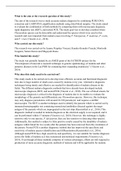What is the aim or the research question of this study?
The aim of the research was to study accurate malaria diagnosis by combining PURE-DNA
extraction and LAMP-DNA amplification methods using dried blood samples. The study aimed
to evaluate the combination of both methods by comparing them with microscopic diagnosis,
rapid diagnostic test (RDT), and nested PCR. The study goal was to develop a method where
Plasmodium species can be detectable and understand the species which were used in this
research and were imported from malaria cases involving P. Falciparum, P. malariae, P. ovale,
and P. vivax (Vincent et al., 2018).
Who carried out this study?
The research was carried out by Jeanne Perpétue Vincent, Kanako Komaki-Yasuda, Moritoshi
Iwagami, Satoru Kawai and Shigeyuki Kano.
Who funded this study?
The study was partially funded by an AMED grant of the SATREPS project for the
“Development of innovative research technique in genetic epidemiology of malaria and other
parasitic diseases in the Lao PDR for containing their expanding endemicity” (Vincent et al.,
2018).
Why does this study need to be carried out?
This study needs to be carried out to develop more efficient, accurate and functional diagnostic
tests due to huge number of death cases caused by malaria every year. Alternative diagnostic
techniques being timely and effective are needed for identification of malaria disease in the
fields. The different malaria diagnostic methods that have already been developed include
microscopic diagnosis, RDT, and nested PCR (Vincent et al., 2018). The use of blood smears for
microscopic diagnosis is critical in the diagnosis of malaria due to its enables to evaluate the
morphology of the parasite and differentiate any Plasmodium species. However, this technique
may only diagnose parasitemia with around 10-100 parasite/µL and requires a skillful
microscopist. The RDT is another technique used to identify the parasite which is carried out by
immunochromatographic test containing monoclonal antibodies directed against the target
antigen of the parasite which are impregnated on the test strip (Kasetsirikul et al., 2016). This
diagnostic method is needed in malaria diagnosis as the electrical supply is not required, and it
can be performed within 15 minutes (Vincent et al., 2018). However, this technique is highly
sensitive only to one species, P. falciparum, they are less sensitive to detecting other species.
Additionally, this method is subject to false positive results caused by the durability of malaria
antigens within blood for two weeks after the parasite has been removed from the circulation of
the patient. Nested PCR is another diagnostic method that has improved the specificity and
sensitivity of malaria species identification and differentiation (Kasetsirikul et al., 2016).
Although nested PCR has a high sensitivity and specificity, it is not suitable for routine diagnosis
across the fields of malaria as it has economical and technical requirements (Vincent et al.,
2018). Even though all these methods comprise of various advantages, efforts are still required in
production of more accurate diagnostic methods of malaria and will be applicable for malaria
, fields. Therefore, combination of PURE-DNA extraction and LAMP-DNA amplification method
is carried out in this study to evaluate accurate malaria diagnosis.
Describe the methodology used in this study.
One hundred and seventeen samples were collected in this study to identify malaria disease using
alternative diagnostic techniques. The techniques performed included microscopic diagnosis,
RDT, DNA extraction from patient blood samples, nested PCR, sequencing analysis and
combination of PURE-DNA extraction, LAMP-DNA amplification method, detection limit, and
statistical analysis (Vincent et al., 2018).
Microscopic diagnosis
Giemsa-stained blood samples were conducted by microscopic diagnosis using light microscopes
where negative samples of malaria were stated to be ≥ 200,000 after counting (Vincent et al.,
2018).
RDT
BinaxNow® Malaria was used to carry out RDT where T1 and T2 bands were included. The
antibody for detecting a Plasmodium falciparum specific HRP2 antigen was found in the T1
band, while the antibody for detecting a Plasmodium common aldolase antigen was found in the
T2 band. Positive bands were counted as pale bands (Vincent et al., 2018).
DNA extraction from patient blood samples
Various techniques were obtained to extract the template DNA for the PCR reactions. QIAamp®
DNA Mini Kit was used in several situations to extract DNA from 200 µL of fresh blood or 100
µL of frozen RBC concentrate. Maxwell RSC Instrument was also employed as an automated
extraction of DNA system. Maxwell RSC Blood DNA kit extracted samples of DNA from 200
µL of fresh blood or 100 µL of frozen RBC concentrate, and elution of DNA samples occurred
in 50 or 100 liters of elution buffer after purification procedures. In all other situations,
extraction of DNA was from 3 dried blood spots with a diameter of 3 mm using a Promega
Maxwell RSC DNA FFPE Kit and the automated Maxwell RSC Instrument, and elution of DNA
occurred in 50 µL of buffer (Vincent et al., 2018).
Nested PCR
Nested PCR used two procedures. The first PCR in both procedures used primers that targeted
universal partial sequences of the Plasmodium genus’ 18S ribosomal RNA gene. Dilutions of the
first PCR results served as templates for the second PCR, which included a species-specific
primer for each human Plasmodium species in each tube (Vincent et al., 2018).
Sequencing analysis
Plasmodium ovale samples were classified further into subspecies where 365 nucleotides of the
18S rRNA were sequenced. Specific sequences of P. ovale were amplified by a nested PCR. A
forward primer, F1 (5’-CTG GTG CCA GCA GCC GCG GRA-3'), and a reverse primer, R1 (5’-
ATG AGA AAT CAA AGT CTT TGG GTT C-3'), were used to target a section of the P. ovale




